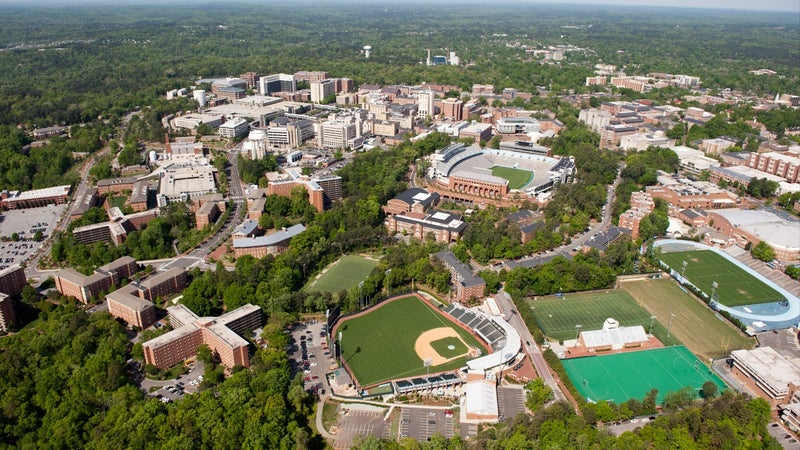Average cost of college

The Bankrate promise
At Bankrate we strive to help you make smarter financial decisions. While we adhere to strict , this post may contain references to products from our partners. Here's an explanation for .
The cost of college in the U.S. has nearly tripled over the last four decades — and things don’t seem to be slowing down, especially now that sky-high inflation is making everything more expensive.
For the 2022-23 academic year, the average cost of tuition and fees for public four-year schools came out to $10,940 for in-state students and $28,240 for out-of-state students, according to the latest data from College Board. Private nonprofit four-year schools amassed a much higher $39,400 average. Add room and board, books and other expenses to the mix, and that bill goes up several thousand dollars more.
Here’s everything you need to know about college costs, including how much tuition has changed over the years and trends that have contributed to these ever-rising costs.
- In the 2022-23 school year, the average annual cost of tuition and fees at a public four-year university was $10,940 for in-state undergraduates and $28,240 for out-of-state undergraduates. Adding in room and board, supplies and other expenses brings that total to $27,940 and $45,240 for in-state and out-of-state students, respectively.
- In the 2022-23 school year, the tuition at a private nonprofit four-year university was $39,400. With room and board, supplies and other expenses, that total rises to $57,570.
- The average annual cost of community college was $3,860 in tuition and fees and $19,230 inclusive of room and board and other expenses for the 2022-23 school year.
- Vermont, New Hampshire, Pennsylvania, Illinois and New Jersey are some of the most expensive states in which to get an undergraduate degree. Florida, Wyoming, Nevada, Utah and Montana are some of the cheapest.
- 16.8 million students are enrolled in college in the U.S. as of spring 2023.
Average cost of college
The average cost of college in the U.S. depends on the type of college you attend and where you attend. Out-of-state students pay much more than in-state students because nonresident students don’t pay taxes to the state where they attend school.
Private colleges are usually the most expensive option because public schools receive funding from the federal government, whereas private colleges receive most of their funding through tuition costs and private donations.
The average cost of college also differs by degree level. A bachelor’s degree costs much less annually than a doctoral degree, though remember that most advanced degrees take only one to two years to complete, while a bachelor’s degree generally takes four years.
Average cost of college by school sector, 2022-23
| Public two-year in-district | Public four-year in-state | Public four-year out-of-state | Private nonprofit four-year | |
|---|---|---|---|---|
| Tuition and fees | $3,860 | $10,940 | $28,240 | $39,400 |
| Room and board | $9,610 | $12,310 | $12,310 | $14,030 |
| Books and supplies, transportation and other expenses | $5,760 | $4,690 | $4,690 | $4,140 |
| Total cost for one academic year | $19,230 | $27,940 | $45,240 | $57,570 |
Source: College Board
Average cost of college by classification, 2022-23
| Bachelor’s (public four-year) | Master’s (public four-year) | Doctoral (public four-year) | Bachelor’s (private nonprofit four-year) | Master’s (private nonprofit four-year) | Doctoral (private nonprofit four-year) | |
|---|---|---|---|---|---|---|
| Tuition and fees | $9,110 | $9,150 | $11,860 | $39,570 | $30,650 | $47,500 |
| Room and board | $11,390 | $11,310 | $12,880 | $12,880 | $13,180 | $16,000 |
| Total cost of tuition, fees and room and board | $20,500 | $20,460 | $24,740 | $52,570 | $43,830 | $63,500 |
Source: College Board
Cost of college for undocumented students
Undocumented students face additional challenges when it comes to financing a college education. Undocumented students — including Deferred Action for Childhood Arrivals (DACA) recipients — aren’t currently eligible to receive federal financial aid. While the Biden administration proposed allowing DACA recipients to receive federal aid opportunities, nothing has been announced by the administration about signing this into law.
Undocumented students are lawfully entitled to a K-12 public education, regardless of state. However, this law doesn’t extend to higher education, and each state has different provisions regarding undocumented students and their ability to attend public schools or receive state aid. Here’s a breakdown of what states allow in regards to postsecondary financial aid, according to the Higher Ed Immigration Portal:
- There are 23 states that allow in-state tuition for undocumented students: California, Colorado, Connecticut, Florida, Hawaii, Kentucky, Virginia, Illinois, Kansas, Maryland, Minnesota, Nebraska, Nevada, New Jersey, New Mexico, New York, Oklahoma, Oregon, Rhode Island, Texas, Utah, Washington and Washington, D.C.
- Nineteen states allow undocumented students to receive state financial aid: California, Colorado, Connecticut, Hawaii, Illinois, Maryland, Minnesota, Nevada, New Jersey, New Mexico, New York, Oregon, Oklahoma, Utah, Rhode Island, Virginia, Texas, Washington and Washington, D.C.
- Ten states prohibit in-state tuition and/or state financial aid for undocumented students: Alabama, Arizona, Georgia, Indiana, Missouri, New Hampshire, North Carolina, Ohio, South Carolina and Wisconsin.
- Three states prohibit undocumented students from enrolling at public institutions: Alabama, Georgia and South Carolina.
Cost of college over time
College tuition costs have been steadily increasing over time, which student loan lender Earnest attributes to recruitment costs, capital improvements, administrative staff expansion, higher staff salaries and more.
College tuition inflation has been rising steadily since the 1980s. With an average annual inflation of eight percent per year since then, tuition inflation has consistently outpaced overall inflation in the economy.
Average undergraduate tuition and fees in 2022 dollars
| Academic year | Private nonprofit four-year | Public four-year | Public two-year |
|---|---|---|---|
| 2012-13 | 37,050 | $11,060 | $4,030 |
| 2013-14 | $37,960 | $11,200 | $4,080 |
| 2014-15 | $38,780 | $11,340 | $4,140 |
| 2015-16 | $40,040 | $11,680 | $4,210 |
| 2016-17 | $40,960 | $11,820 | $4,230 |
| 2017-18 | $41,560 | $11,950 | $4,240 |
| 2018-19 | $41,700 | $11,930 | $4,240 |
| 2019-20 | $42,330 | $11,980 | $4,250 |
| 2020-21 | $42,260 | $11,990 | $4,250 |
| 2021-22 | $41,230 | $11,640 | $4,120 |
| 2022-23 | $39,400 | $10,940 | $3,860 |
Source: College Board
Average cost of college by state
The average cost of public universities and colleges varies by state. The size of the state, the population and the number of colleges in each state are all factors that impact the average cost of college.
Average cost of undergraduate college tuition and fees by state, 2020-21
| Public two-year (in-state) | Public two-year (out-of-state) | Public four-year (in-state) | Public four-year (out-of-state) | Private four-year | |
|---|---|---|---|---|---|
| Alabama | $5,048 | $10,082 | $10,617 | $27,005 | $17,354 |
| Alaska | N/A | N/A | $8,849 | $25,535 | $19,575 |
| Arizona | $2,160 | $6,927 | $11,410 | $25,426 | $13,108 |
| Arkansas | $3,484 | $4,845 | $8,468 | $21,598 | $24,998 |
| California | $1,285 | $8,491 | $8,401 | $34,398 | $38,477 |
| Colorado | $3,468 | $8,889 | $9,269 | $30,930 | $23,128 |
| Connecticut | $4,522 | $13,483 | $14,487 | $36,881 | $43,013 |
| Delaware | N/A | N/A | $11,343 | $31,809 | $14,501 |
| District of Columbia | N/A | N/A | $6,152 | $13,004 | $44,692 |
| Florida | $2,506 | $9,111 | $4,541 | $18,322 | $28,860 |
| Georgia | $3,169 | $8,535 | $7,525 | $23,430 | $30,380 |
| Hawaii | $3,226 | $8,378 | $10,197 | $32,043 | $19,096 |
| Idaho | $3,332 | $8,235 | $7,482 | $24,700 | $6,452 |
| Illinois | $4,180 | $11,166 | $14,579 | $28,660 | $35,894 |
| Indiana | $4,637 | $8,927 | $9,656 | $28,972 | $35,447 |
| Iowa | $5,411 | $6,844 | $9,373 | $27,684 | $35,224 |
| Kansas | $3,648 | $4,828 | $9,081 | $23,945 | $25,523 |
| Kentucky | $4,517 | $15,262 | $10,976 | $25,049 | $26,996 |
| Louisiana | $4,219 | $6,770 | $9,642 | $23,333 | $41,393 |
| Maine | $3,857 | $6,746 | $10,377 | $29,061 | $40,007 |
| Maryland | $4,369 | $10,623 | $9,401 | $26,376 | $44,356 |
| Massachusetts | $5,529 | $10,680 | $13,939 | $32,019 | $49,152 |
| Michigan | $3,756 | $7,707 | $13,716 | $39,427 | $31,055 |
| Minnesota | $5,545 | $6,012 | $11,836 | $24,620 | $34,608 |
| Mississippi | $3,491 | $5,820 | $8,642 | $20,160 | $19,222 |
| Missouri | $3,676 | $6,783 | $9,310 | $21,880 | $27,723 |
| Montana | $3,981 | $9,038 | $6,993 | $26,368 | $32,064 |
| Nebraska | $3,179 | $3,956 | $8,761 | $22,277 | $24,985 |
| Nevada | N/A | N/A | $6,434 | $23,010 | $26,054 |
| New Hampshire | $7,123 | $15,343 | $16,749 | $31,256 | $14,934 |
| New Jersey | $4,919 | $8,136 | $14,184 | $28,682 | $38,586 |
| New Mexico | $1,766 | $6,236 | $7,393 | $21,645 | $24,892 |
| New York | $5,576 | $8,874 | $8,416 | $20,113 | $42,631 |
| North Carolina | $2,474 | $8,511 | $7,260 | $23,136 | $36,772 |
| North Dakota | $5,233 | $6,186 | $9,065 | $13,501 | $16,408 |
| Ohio | $4,416 | $7,888 | $10,049 | $26,213 | $35,352 |
| Oklahoma | $4,194 | $9,320 | $8,064 | $21,737 | $29,905 |
| Oregon | $5,136 | $8,710 | $11,537 | $33,935 | $45,166 |
| Pennsylvania | $5,441 | $12,808 | $14,532 | $25,697 | $43,926 |
| Rhode Island | $4,806 | $12,884 | $13,697 | $32,111 | $45,927 |
| South Carolina | $4,964 | $10,313 | $12,544 | $33,055 | $27,317 |
| South Dakota | $7,326 | $7,224 | $9,012 | $12,924 | $26,740 |
| Tennessee | $4,361 | $17,013 | $10,271 | $25,046 | $29,862 |
| Texas | $2,828 | $7,764 | $8,016 | $25,471 | $37,450 |
| Utah | $3,989 | $12,709 | $6,764 | $21,595 | $7,753 |
| Vermont | $6,920 | $13,640 | $17,593 | $41,963 | $48,300 |
| Virginia | $5,228 | $12,059 | $13,931 | $36,193 | $23,220 |
| Washington | $4,564 | $7,186 | $7,485 | $30,891 | $40,830 |
| West Virginia | $4,470 | $9,781 | $8,252 | $22,475 | $12,413 |
| Wisconsin | $4,534 | $6,552 | $8,782 | $26,970 | $35,674 |
| Wyoming | $3,987 | $9,820 | $4,785 | $14,710 | N/A |
Source: National Center for Education Statistics
Average cost of college by university
The school that you attend is the biggest factor in determining how much student loan debt you could end up with. Generally, the more prestigious and well-known the university, the more expensive it will be.
Average cost of college at America’s most well-known universities, 2023-24
| University | Location | Cost of undergraduate tuition (in-state) | Total expected costs (in-state) |
|---|---|---|---|
| University of California, Berkeley | Berkeley, California | $15,602 | $46,168 |
| Yale University | New Haven, Connecticut | $64,700 | $83,880 |
| Princeton University | Princeton, New Jersey | $59,710 | $83,140 |
| Stanford University | Stanford, California | $61,731 | $87,833 |
| Columbia University | New York City, New York | $68,400 | $89,587 |
| Massachusetts Institute of Technology | Cambridge, Massachusetts | $59,750 | $82,730 |
| Harvard University | Cambridge, Massachusetts | $54,269 | $82,950 |
| University of California, Los Angeles | Los Angeles, California | $14,487 | $38,517 |
| University of Pennsylvania | Philadelphia, Pennsylvania | $58,620 | $89,028 |
| Northwestern University | Evanston, Illinois | $64,887 | $91,290 |
Average cost of college at America’s flagship universities, 2022-23
| University | Estimated in-state undergraduate cost of attendance | Estimated out-of-state undergraduate cost of attendance |
|---|---|---|
| University of Alaska Fairbanks | $20,520–$21,450 | $38,190–$39,120 |
| University of Alabama | $32,054 | $53,364 |
| University of Arkansas | $28,300 | $46,054 |
| University of Arizona | $31,650 | $58,050 |
| University of California: Berkeley | $49,304 | $80,330 |
| University of Colorado at Boulder | $33,466 | $61,312 |
| University of Connecticut | $38,670 | $61,750 |
| University of Delaware | $32,444 | $54,964 |
| University of Florida | $21,810 | $44,088 |
| University of Georgia | $27,542 | $47,416 |
| University of Hawaii at Manoa | $30,331 | $52,363 |
| University of Iowa | $26,883 | $48,846 |
| University of Idaho | $22,846 | $42,082 |
| University of Illinois at Urbana-Champaign | $33,558–$38,744 | $51,870–$59,556 |
| Indiana University: Bloomington | $27,456 | $55,128 |
| University of Kansas | $27,086 | $44,290 |
| University of Kentucky | $33,150 | $53,546 |
| Louisiana State University | $33,982 | $50,659 |
| University of Massachusetts: Amherst | $31,728 | $52,948 |
| University of Maryland: College Park | $29,636 | $57,872 |
| University of Maine | $27,412 | $49,552 |
| University of Michigan | $33,555–$35,655 | $72,153–$76,031 |
| University of Minnesota: Twin Cities | $31,348 | $52,088 |
| University of Missouri: Columbia | $29,636 | $48,808 |
| University of Mississippi | $27,910 | $45,130 |
| University of Montana | $25,534 | $48,936 |
| University of North Carolina at Chapel Hill | $25,258 | $54,352 |
| University of North Dakota | $10,951 (tuition and fees only) | $15,570 (tuition and fees only) |
| University of Nebraska: Lincoln | $27,064 | $44,194 |
| University of New Hampshire | $35,350 | $55,010 |
| Rutgers University: New Brunswick Campus | $36,271 | $54,483 |
| University of New Mexico | $27,471 | $43,777 |
| University of Nevada: Reno | $28,136 | $44,678 |
| State University of New York at Buffalo | $27,294 | $37,204 |
| Ohio State University: Columbus Campus | $26,451 (tuition and room and board only) | $50,688 (tuition and room and board only) |
| University of Oklahoma | $33,250 | $49,817 |
| University of Oregon | $33,639 | $61,275 |
| Pennsylvania State University Park | $34,659.48 | $53,475.48 |
| University of Rhode Island | $29,464 (tuition, fees, room and board only) | $47,946 (tuition, fees, room and board only) |
| University of South Carolina | $34,700 | $55,940 |
| University of South Dakota | $18,856 | $22,366 |
| University of Tennessee: Knoxville | $32,678 | $51,098 |
| University of Texas at Austin | $29,406–$32,346 | $57,420–$65,268 |
| University of Utah | $27,386 | $40,034 |
| University of Virginia | $36,098–$47,994 | $72,250–$86,050 |
| University of Vermont | $35,806 | $61,132 |
| University of Washington | $32,464 | $60,962 |
| University of Wisconsin: Madison | $27,920 | $57,052 |
| West Virginia University | $21,002 (tuition, fees, room and board only) | $38,186 (tuition, fees, room and board only) |
| University of Wyoming | $23,266 | $38,416 |
Average financial aid
College Board found that undergraduate and graduate students received $234.6 billion in grants, work-study, federal student loans and federal tax credits in the 2021-22 school year. On average, graduate students take out larger federal loans than undergraduate students, while undergraduate students receive more grant aid and tax credits. The average financial aid below does not include private scholarships or private student loans, which can also cut down the cost of college significantly.
Average financial aid per student, 2021-22
| Average federal student loans | Average grant aid | Average other aid | |
|---|---|---|---|
| Undergraduate students | $3,780 | $10,590 | $960 |
| Graduate students | $17,680 | $9,120 | $500 |
Source: College Board
The bottom line
The Education Data Initiative reports that while the cost of college has shot up in recent decades, but the last couple of academic years have seen a slight decrease in tuition costs when adjusted for currency inflation. If you are preparing to attend school, research what grants and scholarships may be available to help you offset costs.




